Australian rules football in New Zealand
Australian rules football is a sport first introduced to New Zealand in the 1860s and after a half century hiatus of organised competition, has grown rapidly in participation.[2] Today there are more than five organised competitions located in various regions across the country including Auckland; Canterbury; Wellington; Waikato; Otago, Queenstown and a four-team national competition with a national draft has been contested at the North Harbour Stadium in Auckland since 2016. The national team, The Hawks, have competed against the AFL Academy and were crowned International champions in 2005.
| Australian rules football in New Zealand | |
|---|---|
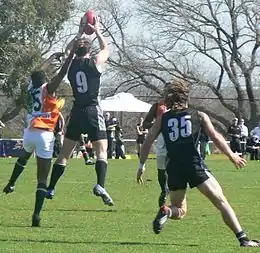 New Zealand player takes a mark in a 2008 International Cup match | |
| Country | New Zealand |
| Governing body | New Zealand AFL |
| National team(s) | New Zealand |
| First played | 1871, Wellington |
| Registered players | 30,000[1] |
| Clubs | 19 |
Club competitions | |
Audience records | |
| Single match | 22,546 – 2013 St Kilda vs Sydney. Westpac Stadium, Wellington |
The first Australian Football League match in New Zealand was played in 1991 and the first AFL premiership match played outside of Australia was the April 25, 2013 match held in Wellington between the Sydney Swans and St Kilda in 2013.[3] The average attendance for AFL premiership matches is 16,027.[4] New Zealand is now considered as having the potential to host a professional team.[5][6] The sport's athletes from New Zealand have become a major talent pool for both professional Australian rules and rugby football competitions. More than 25 players have been listed by clubs in the Australian Football League and more than 15 in the AFLW since 2010, including descendants of both Māori and European New Zealanders.[7][8]
History of Australian rules football in New Zealand
Beginnings
Victorians accounted for more than half of New Zealand's Gold Rush immigrants, including those at Otago, Aorere and Coromandel in the 1850s and 1860s[9] and the associated settlements were later to exhibit influences of early Australian football.
The Christchurch Football club, founded in 1863[10] and playing according to its own rules,[11] one of which was the running bounce (every 4 yards) a feature which appeared 2 years later in Victorian rules. The club adopted rugby rules in 1876.[10][12]
Australian Football is thought to have been first organised in New Zealand around 1868. The Nelson Football Club was formed this year and played a hybrid version of Victorian and Association (soccer) rules in its first two seasons.[13][14][15] By the 1860s, there was regular trade between New Zealand ports and Victoria, and the Victorian rules would have been known by some of the immigrants.[16] The Nelson Club was the first club in New Zealand to adopt Rugby rules, in 1870.[17]
The Wellington Football Club was formed on 12 May 1871.[18] The club initially adopted Victorian rules, but it soon switched to Rugby rules "principally for the reason that the clubs in adjoining provinces play under those rules, and as the club contemplate playing a match with the Nelson club before long the necessity of such a course is apparent." The last match played under Victorian rules was on 24 June 1871.[19] This was not the end of the matter, however, with the club for a short period in 1875 adding the Victorian rule of bouncing the ball. The club reverted to full Rugby rules soon thereafter.[20]
The Dunedin Football Club, formed in 1872, initially played under its own rules. Shortly thereafter, a second club in Dunedin, the Union Club, was formed; it is thought to have adopted Victorian rules. Poor weather meant that few games were played in both the 1873 and 1874 seasons. The Dunedin Club adopted Association (soccer) rules in 1875, while the Union club retained Victorian rules.[21] The clubs were able to compromise, and the first match between the clubs that year was played under Victorian rules on 19 June 1875.[22] The return match was played under Association rules a few weeks later. In 1876, a hybrid match was played between the two clubs. The first half was played according to rugby rules, and the second half according to Victorian Rules.[23] By 1877, both clubs had adopted Rugby rules.[21]
"At the annual meeting of the Union Club in 1877 it was decided by 17 votes to five to adopt the Rugby Union Laws, the club in all its matches with the D.F.C. previous to that date having stipulated for one spell of every game being under Victorian rules."[24]
The first games of football in Auckland were played in 1870 with the rules being a mix of Victorian and Association. In 1873, the Auckland Football Club adopted Rugby rules following a visit by two members of the Wellington Club.[15] At the 1874 AGM of the Auckland Football Club, discussion continued around rules, with motions put to either adopt the Victorian Rules of 1866, or form a committee to consider other rules. These motions were defeated in favour of continuing with Rugby rules.[25]
An Auckland team undertook the first inter-provincial Rugby tour in late 1875. This sparked additional interest in Rugby in regions such as Canterbury and Dunedin where several codes were being played. Ultimately, the success of this led to further representative tours, and proved to be a catalyst for Rugby to become the dominant code in the main regions.[15][21]
Brief Revivals
The Reform Football Club was formed in Wellington in 1879 to "play under the Victorian rules".[26][27] In the same article, several clubs are also reported to have been formed in Dunedin[28] as well as one in Nelson. The Reform club's first practice match was held in the Hon. J. Sheehan's paddock, Hobson St, on 5 April 1879 in front of a "considerable number of spectators".[27] The Reform club enjoyed a reasonable amount of press coverage throughout 1879, though faded into obscurity from 1880. A Victorian Football competition continued to operate with several clubs across New Zealand until 1884.
In 1880, a proposal was put forward to send an Australasian team of players from Melbourne, Sydney and Adelaide to New Zealand and combine and tour England. Otago, one of the game's last strongholds, along with Auckland, pledged to send players for the tour.[29] However the only football team that set sail was the Australian (New South Wales) rugby side in 1881. This helped dispell assurances from Australasian Rules advocates that the Australasian game was fast overtaking Rugby in popularity in Sydney[30] the reaction that year was that in its Otago stronghold 5 of the 8 clubs affiliated with the Otago Rugby Union and saw the code's popularity across the country plummet.[30]
H C A Harrison toured Auckland in 1883 with the cricket team and met with the governing body of Rugby Union proposing that it switch to Victorian Association Rules and would be in turn raising the idea of a universal form of football with football authoritties in England. New Zealand football officials also noted English officials rejection of Harrison's suggestion during his visit to London that rugby clubs there adopt some of the Victorian Rules.[31] The fallout would lead to the continually sharp decline in the fortunes of the game locally.
The 1888-1889 New Zealand Native football team matches saw a Māori team visit Victoria, as part of a year long tour of the UK and Australia, to play a program of Victorian Rules games. The team played eight games, winning three and losing five. It defeated South Melbourne Football Club,[32] which at that stage was Victoria's premier club.
New Century: Australasian rules booms

After being virtually nonexistent since the 1880s, interest in Australian football was rekindled on the back of a wave of immigration from Australia in the first decade of the 20th century.[33] In 1903, the 'New Zealand Association of Australian Football' was formed in Christchurch by a committee of expat Victorians.[34] The league had 4 clubs (City Wanderers, Sydenham, Woolston, and Imperial with a fifth, Carlton, formed a year later). By 1904, a number of leagues were being established throughout the country. In Wellington, a league of five clubs was formed (City, Newtown, Petone, Wanderers, and Federal),[35] and Auckland had three clubs in the new league (Auckland Imperial, Victoria, and Austral football clubs).[36] Other centres also had clubs form in 1904, including Dunedin (Australian Pioneer Football Club[37]), Kaitangata (Wanderers[38]), Waihi and Waikino.
The first inter-provincial match was held between Wellington and Christchurch in August 1905.[39]

In 1905, two New Zealand representatives (one from the North Island and one from the South) attended the Australasian Football Conference where the Australasian Football Council was formed.[40] The North and South Islands did not receive separate representation.[41]
The Auckland league expanded from 1906 to feature additional clubs including the Eden Football Club (who won back-to-back Auckland Australian Football League premierships in 1907 & 1908)[42] and a thriving junior competition.[43] On the south island, regular matches began to be played in Invercargill.[44] All told in 1906 there were more than 60 clubs across 8 associations including the centres of Auckland, Dunedin, Wellington, Palmerston, Christchurch and Napier.[45]
The first national body, the New Zealand Football League, formed in 1907 at the Naval & Family Hotel in Auckland, including representatives from all provinces, which set about planning for the Australian tour, noting the rapidly growing popularity of the code across the country.[46] At the meeting, the NZFL adopted a national code of laws and elected its first president Dr Tracy Inglis.[47]
However the Australasian Football Council president Con Hickey in 1907 was quick to pour cold water on the game's growth in New Zealand, declaring that despite the game being played overseas the primary focus should be on developing the game in Australia, promoting inter-state competition, and that there would be no attempt to "oust rugby" in places where it was growing in popularity.[48]
Wellington defeated Canterbury in a match between the two provinces in July 1907.[49]
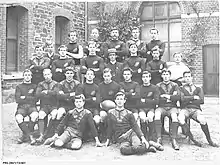
In 1908, New Zealand defeated both New South Wales and Queensland at the Jubilee Australasian Football Carnival an event held in Melbourne, at the Melbourne Cricket Ground, to celebrate 50 years of Australian Football.[40] Despite the country's onfield success, the Australasian Football Council decided to allocate just 20% of its game promotion fund to New Zealand, with the majority going to New South Wales (50%) and Queensland (30%).[50]
By 1909, the game was rapidly growing had become established in Auckland, Waihi, Poverty Bay, Canterbury, Otago, Taihape and Utiki and moves were being made to establish a league in the Southland at Invercargill.[51]
1910s: Decline and reported Rugby League "takeover" in Australia
Many of the leagues went into rapid decline around the end of the decade due to the departure of a number of the Australian players back home. Leagues were also beginning to encounter interference from rugby authorities. The Wellington League of Australian Football for example had encountered issues accessing its primary venue the Basin Reserve from 1908[52][53] and lack of suitable venues led to it folding.
Since the inception of the AFC Victoria (VFL) and South Australia (SAFL) had been pushing for support for the game overseas to be wound up so that the funds could be used to nationalise it and with only one voting member, New Zealand was powerless to defend its position. New Zealand's AFC delegate, E. L. McKeon, in 1908 with the support of AFC president Con Hickey (Victoria), had begun promoting the idea of universal football (amalgamation with rugby league) as the solution to help stave off increased competition to rugby.[54] South Australia's delegate R. F. C Sullivan, strongly in support of the pure Australian Football again moved to exclude New Zealand from the council in 1910[55] and while the motion was defeated[56] the chair Hickey (Victoria) passed a motion that would withdraw all funding to senior competition, a move which the New Zealand delegate called a "death warrant for the sport" in the country. The AFC continued to strongly promote amalgamation with rugby league as a solution for the New Zealand senior football problem. In 1911, the Council decided to reduce New Zealand's funding to £50 (compared to £225 for New South Wales and for £125 for Queensland) and only on the condition that all of it be spent on juniors (no such restrictions were placed on the Australian member states).[57]
The AFC's withdrawal of funding had a detrimental impact with almost all of the senior competitions folding within a year. The last of them, the Auckland competition, folded in 1912 with clubs unable to field sufficient players, and only the junior competition continuing.[58] When New Zealand failed to provide the AFC details on how its 1912 propaganda funds were spent, no subsequent funds were provided in 1913[59] causing the junior competitions also to fold.
The impact of rugby league's expansion was also significant in the sport's decline. Since the early introduction of both codes, New Zealand media regularly took greater interest in interstate contests across all codes between New South Wales and Queensland, particularly in comparing the popularity and progress of rugby football. Though New Zealand teams had toured Australia, due to AFC policy, no Australian Rules teams ever visited New Zealand. Recently introduced, rugby league had steadily grown amongst union followers since its introduction. When the New South Wales rugby league team toured in 1912, the focus on Australian Rugby League generated the perception of a decline in prominence of the Australian game in Australia,[60] There was an awareness in the growing gap between New South Wales and Queensland, and the closing financial gap between the Sydney and Melbourne professional competitions, with league offering paying opportunity for rugby players.[61]
The war was not all doom for the code however, the formation of the Australian and New Zealand Army Corps had a positive effect. In Auckland, 8 clubs reformed at the start of the war with some promising growth prior to the major campaigns.[62]
The Australasian Football Council had begun to promote the Amalgamation of Rugby League and Australian Football in an attempt to stay relevant amid a decline in interest, however this played right into the rugby league's hands. Erroneous media reports widely circulated in 1914 declared the proposed amalgamation to be more of a planned takeover bid by the rugby league[63] that would supplant Australian rules as the Australia's national football code.[64][65][66] It was also reported that the Australian national team to tour New Zealand would be playing the new National Rugby League code.[67] By the time that the proposed takeover was no longer being reported as a "sure thing" the confusion caused had already been done to the confidence of the code locally, already on hold everywhere but Auckland due to the war, and with a new focus on sending a League team to compete against the National League professionals from Australia with matches to be played in Sydney and Brisbane in June 1915 with the replacement for Australian Rules to be played as a curtain-raiser.[68][69][70] Adding to the view that the Australian code would not survive the war, the South Australian Football League's ceasing of its competition was widely reported.[71] With the return of the code in Australia and the failure of the NZ league tour, some had regetted taking the focus on sending a League team to tour Australia[72] with most commentators generally agreeing that despite the hype from Sydney, that Union offered a superior spectacle to League.[73]
The council again moved to exclude New Zealand in 1914.[74] Ultimately, New Zealand withdrew itself from the council after World War I[75] and it removed the reference to Australasia.
Post-war efforts
Nevertheless, some efforts were made to rekindle interest in the code during these years. For instance, in 1930 a call was put out through The Sporting Globe for Australians in New Zealand to restart the sport there.[76] An opinion piece in The Argus in Melbourne's 1935 also proposed that the Australian Football Council might be remiss not to put some effort into promoting the game there.[77]
In 1961, the Melbourne Football Club toured New Zealand during its off season, becoming the first VFL/AFL club to do so.[78]
In 1965 Sydney club Western Suburbs Magpies AFC toured New Zealand an played an exhibition match in Auckland which attracted more than 700 spectators, prompting calls for a local club to compete against visiting sides.[79]
Modern Competition
In 1974, senior competitions began in Christchurch (The Canterbury Australian Rules Football Association),[80] Auckland (Auckland Australian Football League)[81] and Wellington.
In 1978 New Zealand sent a representative team to play against a representative test against the South West Gippsland Football Association.[82]
In 1980, the game's premier league at the time, the VFL, sold its first ever television broadcasting rights to New Zealand, with highlight packages with the Grand Final going live into the country.[83]
In 1995, the competition had grown sufficiently strong to field a national team, the Falcons.
In 1996, the Australian Defence Force side visited New Zealand to conduct clinics and promote the game.[84]
The Arafura Games gave the side the first opportunity to compete at an international level. In 1995, 1997 and 1999, New Zealand took the silver medal in Australian Football at the event in Darwin, Northern Territory, running second to Papua New Guinea.
In 1997, the New Zealand Australian Football Development Foundation (NZAFDF) was formed.
1998 saw the debut of New Zealand born Trent Croad into the Australian Football League, the beginnings of what is a successful career at elite level.
In 1999, NZAFDF incorporated as governing body and was renamed New Zealand AFL.
Exhibition Matches
The years of 1991, 1998, 2000 and 2001 saw official Australian Football League exhibition matches staged in New Zealand so that the AFL could gauge local support.
| Date/Year | Location | Stadium | Teams | Crowd | Media |
|---|---|---|---|---|---|
| 5 October 1991 | Auckland | Western Springs Stadium | Geelong v. St Kilda | 8,500 | Video on YouTube |
| 1 March 1998 | Wellington | Basin Reserve | Melbourne v. Sydney | 7,820 | |
| 29 January 2000 | Wellington | Westpac Stadium | Western Bulldogs v. Hawthorn | 11,666 | |
| 2001 | Wellington | Westpac Stadium | Brisbane Lions v. Adelaide | 7,500 | |
International Success
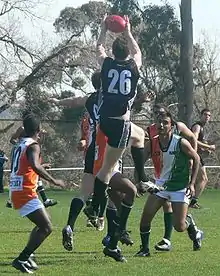
In the inaugural Australian Football International Cup in 2002, New Zealand finished 3rd.
In 2003, local Aussie Rules convert Nick Evans debuted for the famous All Blacks rugby union side against England.[85]
Since 2004, there have been talks of a New Zealand Australian Football League franchise or club relocation as a possible expansion plan for the league. New Zealand fields teams in several Australian competitions in other football codes including the National Rugby League and A-League.
The country came to be regarded as an Australian state by the Australian Football League's international development department.
2005 was a huge year for Australian Football in New Zealand. The national team, the Falcons defeated Papua New Guinea to win the International Cup and were later invited to send a team to the Australian Country Championships.
2006 saw the first-ever live regular season AFL matches on television, which were shown by SKY Network Television.[86]
In November 2008, 17-year-old Liam Ackland was invited to the AIS/AFL academy.[87]
The Hawthorn Football Club, which had been involved in New Zealand since about 2004 and at one point in 2009 had 3 players from New Zealand on its senior list,[88] stepped up its involvement in 2009 with development funding to set up a school competition, the "Hawks Cup", for recruiting and talent identification.[89] The sport boomed at junior levels after approved by the New Zealand Secondary Sports Council.[90] Kurt Heatherley of Tauranga accepted an AFL scholarship in 2010.[88]
2016 saw the successful introduction of a high-level four-team national competition, featuring a national draft with games played out of North Harbour stadium.
In 2021 All Blacks Will Jordan expressed an interest in trialling with an AFL club, describing it as a “a cool game to watch", Jordie Barrett admitted he's a fan, describing it as a "cool sport".[91]
Participation
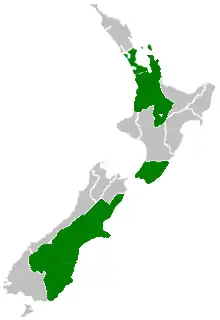
In 2007 New Zealand had around 600 senior players.[92] In 2010, the AFL hoped to increase registered secondary school participants with the introduction of in-school programs.[90] This introduction was highly successful and at the end of 2012, 25,000 Kiwikick participants had been recorded.
By 2016 the number of registered participants had increased to 35,000.
Leagues & Competitions
| Competition | Commenced | Clubs | National Provincial Championship (NPC) side |
|---|---|---|---|
| Auckland | 1974 | 6 | Auckland Buccaneers |
| Canterbury | 1974 | 4 | Canterbury Cobras |
| Wellington | 1974 | 4 | Wellington Tigers |
| Waikato | 2004 | 3 | Waikato Thunder |
| Otago | 2018 | 2 | Otago Riot |
National team
The National men's team is the Hawks. Up to 1908 it was known as the "All Blacks" or the "Silver Ferns" like their rugby counterparts. When the team was reformed it adopted the moniker of the Falcons in 1995. In 2018, a poll was held by AFL New Zealand to rename the side with the current named selected. The team intercolonial tests were for the 1908 tour to Australia, when it competed in the Jubilee Australasian Football Carnival and travelled throughout Australia playing regional sides. However the team was dormant for three quarters of a century until the first internationals at the Arafura Games where they were Silver medallists in 1995 and 1997. The side has competed internationally since the inaugural Australian Football International Cup in 2002, and was crowned International champions in 2005.
A national women's side, the New Zealand Kahu, began as an under 18 national team in 2015[93] before representing women's senior football in 2019 with the aim of debuting internationally for the Australian Football International Cup women's division.[94]
AFL games
AFL club St Kilda signed a historic agreement with, the AFL and Wellington City Council, the Saints will play in New Zealand on Anzac Day each year from 2013 through 2015.[95] They play for the Simpson-Henderson Trophy.
| Round/Date | Host | Score | Guest | Score | Winner and Margin | Venue | Attendance | Media |
| April 25, 2013 | St Kilda | 9.9 (63) | Sydney | 11.13 (79) | Sydney by 16 points | Westpac Stadium, Wellington | 22,546 | Video on YouTube |
| April 25, 2014 | St Kilda | 11.13 (79) | Brisbane Lions | 12.10 (82) | Brisbane by 3 points | Westpac Stadium, Wellington | 13,409 | Video on YouTube |
| April 25, 2015 | St Kilda | 12.9 (81) | Carlton | 18.13 (121) | Carlton by 40 Points | Westpac Stadium, Wellington | 12,125 | Video on YouTube |
Source: Footy Wire
Principal venues
| Wellington | Auckland |
|---|---|
| Wellington Regional Stadium (AFL standard) | Outer Oval, North Harbour Stadium |
| Capacity: 34,500 | Capacity: 5,000 |
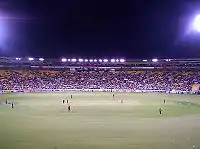 |
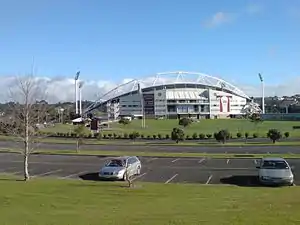 |
Audience
Attendance
The record attendance for an Australian rules game in New Zealand is 22,546 which was set in 2013 beteeen St Kilda vs Sydney at Westpac Stadium in Wellington. The average attendance for AFL premiership matches played in New Zealand is 16,027.
Television
- SKY Network Television (one delayed AFL match per week and Highlights)
- Sommet Sports (six live games each week, the remaining matches broadcast on delayed coverage)[96]
- TVNZ Duke[97]
Notable players
Men's
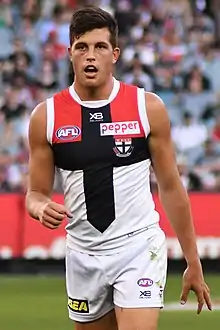 Rowan Marshall is from Taranaki
Rowan Marshall is from Taranaki.jpg.webp)
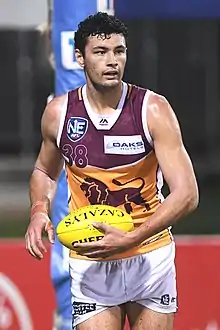 Connor Ballenden is from Auckland
Connor Ballenden is from Auckland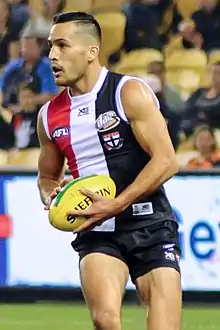 Shane Savage is from Auckland
Shane Savage is from Auckland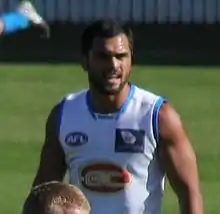 Karmichael Hunt is from Auckland
Karmichael Hunt is from Auckland Trent Croad is from Auckland
Trent Croad is from Auckland Rupert Wills playing for Collingwood in 2017
Rupert Wills playing for Collingwood in 2017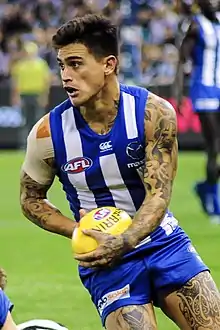 Marley Williams playing for North Melbourne in 2018
Marley Williams playing for North Melbourne in 2018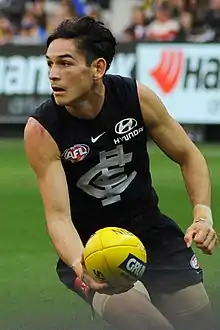 Zac Fisher playing for Carlton in 2018
Zac Fisher playing for Carlton in 2018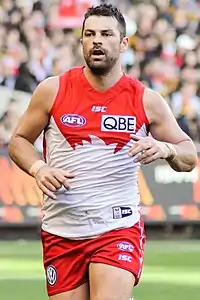 Heath Grundy, Sydney Swans premiership player in 2017
Heath Grundy, Sydney Swans premiership player in 2017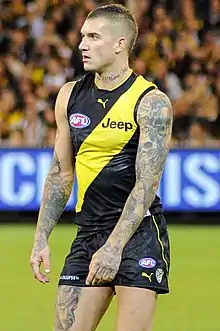 Dustin Martin, Richmond Brownlow medallist and premiership player in 2017
Dustin Martin, Richmond Brownlow medallist and premiership player in 2017 Mark Blicavs playing for Geelong in 2019
Mark Blicavs playing for Geelong in 2019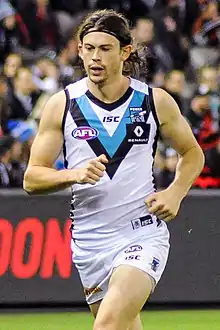 Jasper Pittard playing for Port Adelaide in 2017
Jasper Pittard playing for Port Adelaide in 2017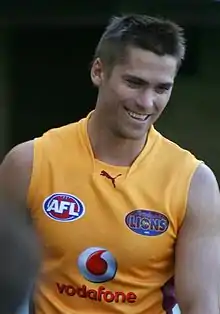 Simon Black, Brisbane Brownlow medallist and 3 time premiership player in 2008
Simon Black, Brisbane Brownlow medallist and 3 time premiership player in 2008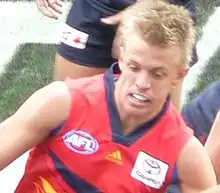 Nathan Van Berlo playing for Adelaide in 2007
Nathan Van Berlo playing for Adelaide in 2007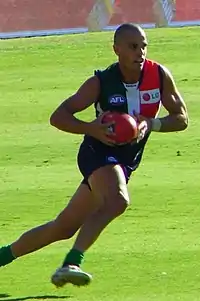 Brett Peake playing for Fremantle in 2006
Brett Peake playing for Fremantle in 2006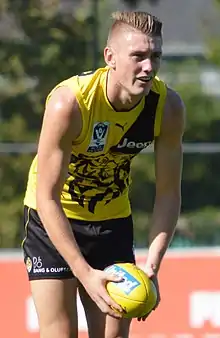 Callum Moore playing for Richmond in 2018
Callum Moore playing for Richmond in 2018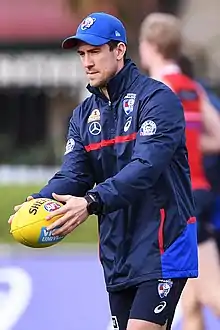 Jordan Russell for the Western Bulldogs in 2018
Jordan Russell for the Western Bulldogs in 2018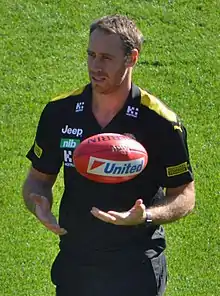 Ben Rutten as Richmond assistant coach in 2018
Ben Rutten as Richmond assistant coach in 2018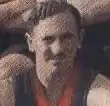 Barney Wood was from Wellington (pictured in 1928)
Barney Wood was from Wellington (pictured in 1928)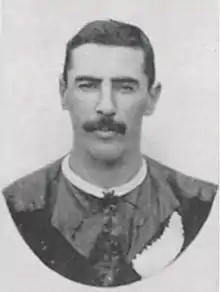 George A. Gillett (dual rugby international) of Leeston in Canterbury was part of New Zealand's 1908 Melbourne carnival team
George A. Gillett (dual rugby international) of Leeston in Canterbury was part of New Zealand's 1908 Melbourne carnival team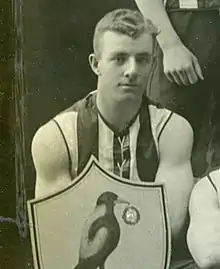 Bob Bryce was from Dunedin (pictured in 1901)
Bob Bryce was from Dunedin (pictured in 1901)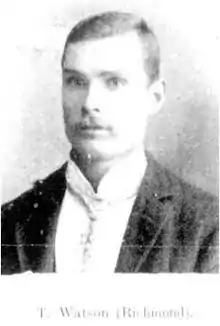 Tom Watson was from Dunedin (pictured in 1899)
Tom Watson was from Dunedin (pictured in 1899)
| Currently on an AFL senior list |
| Player | VFL/AFL Years* | VFL/AFL Matches* | Clubs played for/plays for | Connections to New Zealand, References |
|---|---|---|---|---|
| Mykelti Lefau | 2022- | - | Richmond (VFL)/ Casey (VFL) | Born, Samoan father, New Zealand mother[98][99] |
| Misilifi Faimalo | 2022- | - | Richmond (VFL) | Born, Maori[100] |
| Archie Perkins | 2021- | - | Essendon (AFL) | Both parents[101] |
| Toby Wooller | 2021- | - | Brisbane (AFL) | Born[102] |
| Louis Butler | 2021- | 3 | Western Bulldogs (AFL) | Born[103] |
| Connor Ballenden | 2018– | 2 | Brisbane (AFL) | Born[104] |
| Zac Fisher | 2017– | 64 | Carlton (AFL) | Mother Maori[105] |
| Rowan Marshall | 2017– | 52 | St Kilda (AFL) | Born Taranaki[106][107] |
| Jake Patmore | 2017–2020 | - | Port Adelaide (AFL) | Maori: Ngati Maru[108] |
| Callum Moore | 2016-2020 | 10 | Richmond (AFL) | Parents[109][110][111] |
| Rupert Wills | 2016–2020 | 23 | Collingwood (AFL) | Born and raised[106][107] |
| Joe Baker-Thomas | 2014–2017 | - | New Zealand / St Kilda (AFL) | Born and raised[112] (international scholarship) |
| Kurt Heatherley | 2014–2018 | 5 | Hawthorn (AFL) | Born and raised in Tauranga[113] (international rookie) |
| Shem Tatupu | 2013–2016 | - | Hawthorn (VFL + AFL) / Melbourne Storm (NRL) | Born and raised[114] (rookie) |
| Maia Westrup | 2013–2015 | - | Melbourne (AFL) | Born and raised[115] New Zealand High Performance Acadeny. (international scholarship) |
| Siopi Ngata | 2013–2015 | - | Hawthorn (AFL) | Born and raised[116] AFL Combine. (international scholarship) |
| Barclay Miller | 2013–2018 | - | New Zealand / St Kilda (AFL) | Born and raised[117] (international scholarship) |
| Mark Blicavs | 2013– | 179 | Geelong (AFL) | Father[118][119][120] |
| Marley Williams | 2012–2020 | 81 | North Melbourne (AFL) | Father (Maori)[121] |
| Daniel Pearce | 2012–2015 | 6 | Western Bulldogs (AFL) | Father[121] |
| Jasper Pittard | 2011–2020 | 115 | Port Adelaide (AFL) | Mother[121] |
| Karmichael Hunt | 2011–2014 | 44 | Gold Coast (AFL) | Born Auckland, father from Cook Islands, mother from Samoa[122] |
| Max Gawn | 2010– | 74 | Melbourne (AFL) | Raised in Greymouth[123][124] |
| Dustin Martin | 2010– | 178 | Richmond (AFL) | Father (Maori: Ngati Maru)[125] |
| Shane Savage | 2009–2020 | 56 | St Kilda (AFL) | Born Auckland; Father (Maori)[126][127] |
| Jay van Berlo | 2009–2012 | 32 | Fremantle (AFL) | Both parents[128] |
| Greg Broughton | 2009–2015 | 110 | Fremantle / Gold Coast (AFL) | Father (Maori)[129] |
| Brent Renouf | 2008–2014 | 68 | Hawthorn (AFL) | Born, both parents[127][130] |
| Paul Bower | 2006–2012 | 70 | Carlton (AFL) | Maori mother[131] |
| Adam Campbell | 2006–2009 | 13 | Fremantle (AFL) | Born Christchurch, Parents[132] |
| Heath Grundy | 2005–2019 | 139 | Sydney (AFL) | Mother[133] |
| Nathan Van Berlo | 2005–2016 | 182 | Adelaide (AFL) | Both parents[128] |
| Jordan Russell[121] | 2005–2013 | 125 | Carlton / Collingwood (AFL) | Mother[128] |
| Brett Peake | 2005–2012 | 118 | Fremantle / St Kilda (AFL) | Maori[131] |
| Beau Maister | 2005–2014 | 44 | West Coast / St Kilda (AFL) | Mother from Christchurch[134] |
| Aaron Edwards | 2003–2014 | 91 | Kangaroos (AFL) | Father, Samoan mother[135] |
| Ben Rutten | 2003–2014 | 229 | Adelaide (AFL) | Mother[121] |
| Trent Croad | 1998–2009 | 222 | Hawthorn (AFL) | Born, Parents[136] |
| Simon Black | 1998–2013 | 322 | Brisbane (AFL) | Father (born)[121] |
| Daniel McAlister | 1997–2002 | 6 | Essendon (AFL) | Born, part Maori[131] |
| Danny Dickfos | 1996–1999 | 65 | Brisbane (AFL) | Part Maori[137] |
| Donald Dickie | 1996–2000 | 55 | Port Adelaide (AFL) | Born, part Maori |
| Wayne Schwass | 1988–2002 | 282 | North Melbourne/Kangaroos (VFL/AFL) / Sydney (AFL) | Born, part Maori[138] |
| Warren Jones | 1978–1988 | 123 | Carlton (VFL/AFL) | Born Wellington[139] |
| Brian Peake | 1974-1977 | 66 | Geelong (VFL/AFL) | Maori[131] |
| Peter Bennett | 1944–1954 | 103 | Hawthorn / Essendon (VFL/AFL) | Born[140] |
| Marty McDonnell | 1939–1950 | 92 | Footscray (VFL/AFL) | Born[141] |
| Joe Sellwood | 1930–1945 | 181 | Geelong (VFL/AFL) | Born[142] |
| Arthur Watson | 1929 | 2 | Hawthorn(VFL/AFL) | Born Onehunga[143] |
| Barney Wood | 1928 | 5 | Melbourne (VFL/AFL) | Born Wellington[144] |
| Thomas O'Halloran | 1925–1934 | 142 | Richmond (VFL/AFL) | Born[145] |
| Jack Barnett | 1924-26 | 13 | Richmond (VFL/AFL) | Born Auckland[146] |
| Harry Haughton | 1912–19 | 113 | Carlton (VFL/AFL) | Born Whanganui[147] |
| Frank Macky | 1911 | 7 | Melbourne University (VFL/AFL) | Born Auckland[148] |
| Bill Mearns | 1910 | 3 | St Kilda (VFL/AFL) | Born Tokatoka[149] |
| Dave McColl | 1908 | 5 | South Melbourne (VFL/AFL) | Born Dunedin[150] |
| Tom Watson | 1902-1904 | 15 | Richmond (VFA), Carlton / Melbourne (VFL/AFL) | Born Dunedin[151] |
| Charlie Meadway | 1879-1907 | 4 | Carlton / Collingwood (VFL/AFL) | Born Dunedin[152] |
| Bob Bryce | 1899-1902 | 18 | South Melbourne / Collingwood (VFL/AFL) | Born Dunedin[153] |
| Jim Cowcher | 1898 | 5 | Carlton (VFL/AFL) | Born Napier[139] |
| Artie Machin | 1898 | 3 | South Melbourne (VFL/AFL) | Born Timaru[154] |
| Abe McDougall | 1898-1902 | 59 | Fitzroy (VFL/AFL) | Born Auckland[155] |
| Jack Southern | 1891-1899 | 31 | South Melbourne (VFA,VFL/AFL) | Born Dunedin[156] |
Women's
.png.webp) Brooke Walker is from Christchurch
Brooke Walker is from Christchurch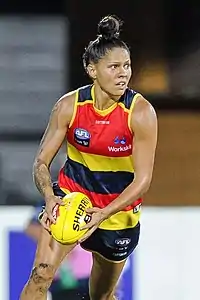 Stevie-Lee Thompson is from Hawke's Bay
Stevie-Lee Thompson is from Hawke's Bay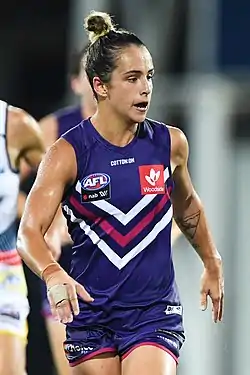 Angelique Stannett playing for Fremantle in 2019
Angelique Stannett playing for Fremantle in 2019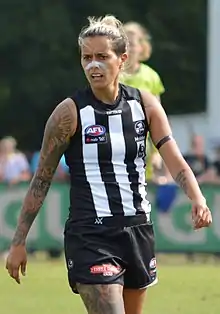 Moana Hope playing for club Collingwood in 2018
Moana Hope playing for club Collingwood in 2018.jpg.webp) Tahlia Randall playing for North Melbourne
Tahlia Randall playing for North Melbourne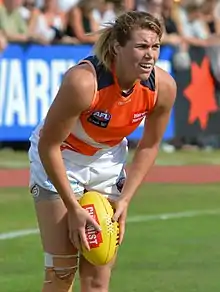 Jacinda Barclay playing for Greater Western Sydney in 2018
Jacinda Barclay playing for Greater Western Sydney in 2018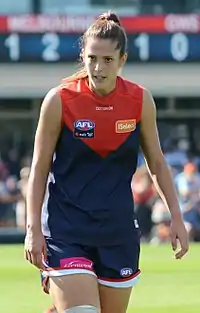 Lauren Pearce playing for Melbourne in 2018
Lauren Pearce playing for Melbourne in 2018 Richelle Cranston playing for Melbourne in 2017
Richelle Cranston playing for Melbourne in 2017
| Currently on an AFLW senior list |
| Player | AFLW Years* | AFLW Matches* | Clubs played for/plays for | Connections to New Zealand, References |
|---|---|---|---|---|
| Makaela Tuhakaraina | 2021– | 6 | Fremantle | Born and raised[157] |
| Lucy Single | 2021– | 9 | Gold Coast | Raised in New Zealand up to age of 10[158] |
| Indy Tahau | 2021– | 8 | Brisbane | Family[159] |
| Vaomua Laloifi | 2020– | 15 | Carlton | Born in Samoa, raised in New Zealand[160][161] |
| Dee Heslop | 2020– | 16 | Gold Coast | Born and raised in Auckland[162] |
| Poppy Kelly | 2020– | 6 | Richmond | Both parents born (Maori mother)[163] |
| Mhicca Carter | 2020-2021 | 1 | West Coast | Raised in Blenheim[164] |
| Angelique Stannett | 2019– | 25 | Fremantle | Born[165] |
| Jesse Tawhiao-Wardlaw | 2019– | 25 | Brisbane | Born and raised in Ashburton to Aucklander mother and Christchurch father.[166] Maori. |
| Brooke Walker | 2019– | 16 | Carlton | Born and raised in Christchurch[167] |
| Tahlia Randall | 2017– | 46 | Brisbane / North Melbourne | Mother from Titirangi[168][169] |
| Stevie-Lee Thompson | 2017– | 41 | Adelaide | Maori parents, raised in Hawke's Bay from age of 4[170] |
| Richelle Cranston | 2017– | 34 | Melbourne / Geelong / Western Bulldogs | Maori, raised in New Zealand[171] |
| Lauren Pearce | 2017– | 33 | Melbourne | Father[172] |
| Jacinda Barclay | 2017–2020 | 23 | GWS | Both parents[173] |
| Moana Hope | 2017–2019 | 20 | Collingwood / North Melbourne | Maori mother[174] |
| Jade Ransfield | 2016–2017 | - | Brisbane | Born, moved to Australia as child[175] |
References
- Herald Sun – New Zealand AFL CEO Rob Vanstam says there is growing interest in the game across the Tasman
- NZ coverage reaches new heights
- stuff.co.nz – AFL confirmed for capital next year
- St Kilda v Brisbane Lions – AFL.com
- Wilson, Caroline (26 April 2013). "We want AFL team: Kiwis". The Age.
- Thompson, Matt (2 November 2013). "Saints could find themselves relocated to NZ, warns Thomas". AFL.com.au.
- AFL players with international backgrounds#New Zealand
- stuff.co.nz – Heatherley waiting for word on his AFL future
- Inflow from the Australian Colonies
- Christchurch Football Club – Club History
- RUGBY UNION FOOTBALL – HISTORY – 1966 Encyclopaedia of New Zealand
- Mosley, M. (1885), Illustrated Guide to Christchurch and Neighbourhood, J. T. Smith & Co., p. 120
- Swan, Arthur C. (1948). History of New Zealand Rugby Football, Vol. 1, 1870–1945.
- "Early Rugby in the Manawatu – Talk" Clive Akers, 10 April 2008
- Camilla Obel, "Unions, Leagues and Franchises: The Social Organisation of Rugby Union in New Zealand", University of Canterbury thesis, 2001
- Blainey, Geoffrey (2003), A game of our own: the origins of Australian football, Black Inc, p. 142
- Turley, A. (2009). Rugby-The Pioneer Years, How Rugby Captured the Heart of a Nation, Auckland, N.Z.: Harper Collins.
- Wellington Independent, 12 May 1871
- Wellington Independent, 24 June 1871
- Evening Post 3 May 1875 & 12 May 1875
- Rex W. Thomson, "Provincial Rugby in New Zealand: Otago's Academic Pioneers", Fall 1996
- Otago Witness, 26 June 1875
- "When 'Rules' ruled Sydney". Australian Broadcasting Corporation. 19 March 2008.
- Otago Witness, 6 June 1889, Page 26
- Daily Southern Cross, 2 May 1874.
- OTAGO DAILY TIMES, ISSUE 5342, 3 APRIL 1879, PAGE 2
- EVENING POST, VOLUME XVII, ISSUE 379, 27 MARCH 1879, PAGE 3
- EVENING STAR, ISSUE 5050, 12 MAY 1879, PAGE 2
- EVENING STAR, ISSUE 5545, 14 DECEMBER 1880, PAGE 2
- OTAGO WITNESS, ISSUE 1756, 18 JULY 1885, PAGE 20
- AUCKLAND STAR, VOLUME XXVI, ISSUE 4533, 9 DECEMBER 1884, PAGE 2
- Ryan, Greg (1993). Forerunners of the All Blacks. Christchurch, New Zealand: Canterbury University Press. p. 144. ISBN 0-908812-30-2.
- Jock Phillips. 'History of immigration – Migration: 1900 to 1914', Te Ara – the Encyclopedia of New Zealand, updated 12 June 2013
- Otago Witness, 1 April 1903, Page 50
- Evening Post, 3 June 1904 and 22 June 1904
- New Zealand Herald, 14 May 1904
- Otago Witness, 11 May 1904, page 53
- Bruce Herald, 7 June 1904, Page 5
- PRESS, VOLUME LXII, ISSUE 12284, 30 AUGUST 1905, PAGE 5
- "A False Dawn". Archived from the original on 25 December 2007. Retrieved 26 September 2007.
- "Football – a National Council formed". The Express and Telegraph. Adelaide, SA. 8 November 1906. p. 3.
- Auckland Australian Football League Archived 24 July 2011 at the Wayback Machine
- AUSTRALIAN FOOTBALL LEAGUE. AUCKLAND STAR, VOLUME XXXVII, ISSUE 89, 14 APRIL 1906, PAGE 6
- MATAURA ENSIGN, 27 SEPTEMBER 1906, PAGE 2
- "AUSTRALIAN FOOTBALL". The Australian Star. No. 5726. New South Wales, Australia. 21 June 1906. p. 4 (FIRST EDITION). Retrieved 27 October 2021 – via National Library of Australia.
- AUCKLAND STAR, VOLUME XXXVIII, ISSUE 75, 28 MARCH 1907, PAGE 4
- AUCKLAND STAR, VOLUME XXXVIII, ISSUE 77, 1 APRIL 1907, PAGE 3
- The Daily Telegraph (Sydney, NSW : 1883 - 1930) Mon 2 Sep 1907
- "AUSTRALIAN FOOTBALL IN NEW ZEALAND". The Age. No. 16, 324. Victoria, Australia. 8 July 1907. p. 5. Retrieved 5 November 2021 – via National Library of Australia.
- Pg.2 Mount Alexander Mail (Vic. : 1854 - 1917) Fri 28 Aug 1908
- SOUTHLAND TIMES, ISSUE 14099, 4 MAY 1909, PAGE 3
- EVENING POST, VOLUME LXXV, ISSUE 78, 1 APRIL 1908, PAGE 8
- NEW ZEALAND TIMES, VOLUME XXXI, ISSUE 6817, 13 MAY 1909, PAGE 6
- "UNIVERSAL FOOTBALL". The Empire. Vol. II, no. 67. Western Australia. 29 August 1908. p. 3. Retrieved 14 November 2021 – via National Library of Australia.
- "AUSTRALIAN FOOTBALL". The Sun. No. 112. New South Wales, Australia. 8 November 1910. p. 5 (LATEST EDITION). Retrieved 28 October 2021 – via National Library of Australia.
- "Australasian Football Council". The Chronicle. Vol. LIII, no. 2726. Adelaide, SA. 19 November 1910. p. 24.
- AUSTRALIAN RULES Page 55 The Sydney Mail and New South Wales Advertiser Wed 16 Aug 1911
- New Zealand Herald, 4 May 1912, Auckland Library Copy
- "Council executive meeting". The Age. Melbourne, VIC. 7 November 1912. p. 15.
- NEW ZEALAND HERALD, VOLUME XLIX, ISSUE 15070, 13 AUGUST 1912, PAGE 9
- STAR (CHRISTCHURCH), ISSUE 10801, 21 JUNE 1913, PAGE 6
- "Australian Football in New Zealand". Sunday Times. No. 1482. New South Wales, Australia. 14 June 1914. p. 15. Retrieved 5 November 2021 – via National Library of Australia.
- WANGANUI HERALD, VOLUME XLIX, ISSUE 14454, 19 NOVEMBER 1914, PAGE 3
- FOOTBALL AMALGAMATION. AUCKLAND STAR, VOLUME XLV, ISSUE 276, 19 NOVEMBER 1914, PAGE 6
- AUCKLAND STAR, VOLUME XLV, ISSUE 290, 5 DECEMBER 1914, PAGE 2 (SUPPLEMENT)
- THE NEWER FOOTBALL. SUN (CHRISTCHURCH), VOLUME I, ISSUE 311, 5 FEBRUARY 1915, PAGE 2
- PRESS, VOLUME LI, ISSUE 15201, 12 FEBRUARY 1915, PAGE 4
- LEAGUE FOOTBALL. PRESS, VOLUME LI, ISSUE 15201, 12 FEBRUARY 1915, PAGE 4
- SOUTHLAND TIMES, ISSUE 17482, 10 APRIL 1915, PAGE 10
- WANGANUI HERALD, VOLUME L, ISSUE 14576, 13 APRIL 1915, PAGE 6
- DOMINION, VOLUME 9, ISSUE 2697, 17 FEBRUARY 1916, PAGE 4
- SOUTHLAND TIMES, ISSUE 18149, 25 JULY 1919, PAGE 3
- GREYMOUTH EVENING STAR, 21 AUGUST 1920, PAGE 2
- "Australasian control". The Evening Star. Kalgoorlie, WA. 27 June 1914. p. 4.
- "Australasian Football Council". The Age. Melbourne, VIC. 29 December 1919. p. 5.
- "For New Zealand Aussie Rules Players" Pg. 9 The Sporting Globe. Wed 20 Aug, 1930.
- Is New Zealand Ready? The Argus. Pg.27 Sat 1 Jun 1935
- "Melbourne in AFL first". Archived from the original on 6 July 2011. Retrieved 25 August 2008.
- "NZ may get Rules team" Pg.16 The Canberra Times. Tue 12 Oct 1965
- "League History - Canterbury AFL".
- "Archived copy". Archived from the original on 14 October 2008. Retrieved 8 August 2009.
{{cite web}}: CS1 maint: archived copy as title (link) - "NZ rules team" The Canberra Times. Page.14 Fri 9 Jun 1978
- "Blues set for very tough game with Magpies". The Canberra Times. Vol. 55, no. 16, 423. Australian Capital Territory, Australia. 12 September 1980. p. 17. Retrieved 17 December 2021 – via National Library of Australia.
- "DECADE OF DOMINANCE UNBROKEN!". Raaf News. Vol. 38, no. 8. 1 September 1996. p. 20. Retrieved 5 November 2021 – via National Library of Australia.
- All Black almost a Swan from news.com.au
- World Footy News – Live footy telecasts for New Zealand
- International juniors head for AIS and Junior Oceania Cup
- HANZ-UP! AFL Program Archived 23 May 2010 at the Wayback Machine hawthornfc.com.au
- Hawks cast recruiting net across Tasman from the Herald Sun
- Rushworth, Anna (29 November 2009). "Aussies luring Kiwi kids into kicking and jumping game". The New Zealand Herald. Retrieved 17 September 2011.
- All Blacks duo hint at potential cross-code moves to NRL and AFL Alex McLeod 11th December, 2021
- AFL International Census 2007 Archived 24 May 2011 at the Wayback Machine
- NZ AFL KAHU SQUAD ANNOUNCED TO TAKE ON WOOMERA'S School Sport new Zealand
- A small but spectacular mark in AFL history
- "Archived copy". Archived from the original on 6 November 2013. Retrieved 13 November 2013.
{{cite web}}: CS1 maint: archived copy as title (link) - Sommet Sports broadcasting on Sky Sports
- We're playing their game here: The Kiwis embracing Aussie Rules from NZ Herald 31 Aug, 2017
- NZ Falcons duo sign with Richmond VFL for 2022
- Lefau's journey from rugby to footy
- NZ Falcons duo sign with Richmond VFL for 2022
- Going Places: How footy's sanctuary helped Archie get ready to fly By Callum Twomey on Nov 26, 2020
- Prime, Toby (3 September 2017). "Like grandfather, like grandson". Herald Sun.
- "2020 Multicultural Map revealed". AFLPA. Retrieved 6 October 2020.
- "Queenslander looms as top draft prospect".
- De Bolfo, Tony (20 April 2017). "Fisher seizing the moment". Carlton Football Club. Retrieved 24 April 2019.
- New two-year deal for Kiwi-born Saint
- Ryan, Peter (8 May 2020). "Saints' next big thing comes from rugby roots". The Age. Retrieved 27 May 2020.
- Port Adelaide draft Kiwi Patmore November 27, 2017
- Marshall, Konrad (18 November 2019). Stronger & Bolder. Melbourne, Australia: Slattery Media Group. p. 119. ISBN 9781743796375.
- Michell, Tim (27 November 2015). "Calder Cannons forward Callum Moore off to Richmond after rookie draft selection". Moreland Leader. News Corp. Retrieved 4 January 2017.
- Greenberg, Tony (18 August 2016). "One Moore Tiger debutant". Richmond FC. Bigpond. Retrieved 4 January 2017.
- "Joe Baker-Thomas nominated for award".
- "Hawks sign Kiwi to International Scholarship - World Footy News".
- afl.com.au
- "AFLNZ 2012 Annual Report".
- "College sport: AFL team bag rugby talent".
- "Saints back Miller to represent New Zealand". 20 March 2018.
- Geelong Cats Football Club. Player Profile: 48 Mark Blicavs Archived 15 August 2012 at the Wayback Machine. Retrieved 2012-10-04.
- Blicavs just the shot to give AIS a much-needed boost. The Canberra Times (26 November 2011). Retrieved 2012-10-04.
- Jayco Rangers Sign Sara Blicavs Archived 15 July 2014 at the Wayback Machine (11 April 2012). Basketball Australia. Women's National Basketball League. Retrieved 2012-10-04.
- 118 players with multicultural background on AFL lists
- Masters, Roy (1 August 2009). "Hunt and the hunted: AFL targets NRL's monopoly on islanders". The Sydney Morning Herald.
- "If Aussies Win then Max's Shirt is 'Gawn'". AFL Players Association. 24 March 2015. Retrieved 23 April 2010.
- Flanagan, Martin (18 March 2016). "Big Max a true Demon believer". The Age. Fairfax Media. Retrieved 23 April 2010.
- Langmaid, Aaron (30 June 2010). "Dustin Martin and father go neck and neck in Maori stakes". Courier Mail. Retrieved 1 October 2017.
- 'Proud Kiwi' looks forward to homecoming
- http://www.realfooty.com.au/news/news/forget-irish-clubs-turn-to-kiwis/2009/03/12/1236447397700.html
- "An old head on young shoulders". Archived from the original on 3 May 2011. Retrieved 23 April 2014.
- "Broughton looks forward". Archived from the original on 30 December 2012. Retrieved 23 April 2014.
- McClure, Geoff (2 July 2008). "Kiwi Brent joins select club". The Age. Melbourne.
- The Footy Almanac – Asia-Pacific Team of the Century
- "International Players in Australia - World Footy News".
- Bidwell, Hamish (23 April 2013). "Swans hope to win over a few Kiwis".
- Beau Maister – Heritage Team Acceptance
- "Making his mark". Archived from the original on 2 December 2007. Retrieved 23 April 2014.
- "All Blacks tackle Waverley Park". Archived from the original on 6 July 2011. Retrieved 26 June 2009.
- Losing Hayne would be disaster DANIEL LANE for the Sydney Morning Herald 6 June 2010M
- Māori overseas – Retaining Māori culture in Australia – Te Ara Encyclopedia of New Zealand
- "Carlton's International XVIII".
- Holmesby, Russell; Main, Jim (2007). The Encyclopedia Of AFL Footballers. BAS Publishing. ISBN 978-1-920910-78-5.
- "World War II Roll: Martin Joseph McDonald". Department of Veterans Affairs.
- "Joe Sellwood (Geelong)". australianfootball.com. Retrieved 4 August 2014.
- Holmesby, Russell; Main, Jim (2014). The Encyclopedia of AFL Footballers: every AFL/VFL player since 1897 (10th ed.). Seaford, Victoria: BAS Publishing. p. 927. ISBN 978-1-921496-32-5.
- Births: Wood, The (Wellington, N.Z.) Evening Post, (23 December 1901), p.6.
- "Tom O'Halloran - Player Bio". Australian Football. Retrieved 5 December 2014.
- Holmesby, Russell; Main, Jim (2014). The Encyclopedia of AFL Footballers: every AFL/VFL player since 1897 (10th ed.). Seaford, Victoria: BAS Publishing. p. 46. ISBN 978-1-921496-32-5.
- "Blueseum - History of the Carlton Football Club | Harry Haughton".
- Orange Blossoms: Macky—Taylor, The Waikato Independent, (Saturday, 4 March 1916), p.5.
- Holmesby, Russell; Main, Jim (2014). The Encyclopedia of AFL Footballers: every AFL/VFL player since 1897 (10th ed.). Seaford, Victoria: BAS Publishing. p. 601. ISBN 978-1-921496-32-5.
- Holmesby, Russell; Main, Jim (2014). The Encyclopedia of AFL Footballers: every AFL/VFL player since 1897 (10th ed.). Seaford, Victoria: BAS Publishing. p. 568. ISBN 978-1-921496-32-5.
- Holmesby, Russell; Main, Jim (2009). The Encyclopedia of AFL Footballers: every AFL/VFL player since 1897 (8th ed.). Seaford, Victoria: BAS Publishing. p. 870. ISBN 978-1-921496-00-4.
- "Charlie Meadway". Blueseum. Retrieved 15 January 2015.
- Holmesby, Russell; Main, Jim (2014). The Encyclopedia of AFL Footballers: every AFL/VFL player since 1897 (10th ed.). Seaford, Victoria: BAS Publishing. p. 108. ISBN 978-1-921496-32-5.
- Holmesby, Russell; Main, Jim (2014). The Encyclopedia of AFL Footballers: every AFL/VFL player since 1897 (10th ed.). Melbourne, Victoria: Bas Publishing. p. 537. ISBN 978-1-921496-32-5.
- Holmesby, Russell; Main, Jim (2014). The Encyclopedia of AFL Footballers: every AFL/VFL player since 1897 (10th ed.). Melbourne, Victoria: Bas Publishing. p. 574. ISBN 978-1-921496-32-5.
- Holmesby, Russell; Main, Jim (2014). The Encyclopedia of AFL Footballers: every AFL/VFL player since 1897 (10th ed.). Seaford, Victoria: BAS Publishing. p. 836. ISBN 978-1-921496-32-5.
- "REVEALED: U19 All-Australian team, 16-year-old gun the national MVP".
- "Lucy Single has excelled at Aussie rules for Bond University since moving from New Zealand". Gold Coast Bulletin. 7 September 2020. Retrieved 25 November 2020.
- "Indy Tahau Blazes Own Trail from Cunnamulla to AFLW GF".
- "10 questions with … Blue Mua Laloifi".
- "Vaomua Laloifi: A journey like no other".
- "Dee Heslop puts case forward for spot on Gold Coast Suns AFLW list". Gold Coast Bulletin. 17 July 2019. Retrieved 14 January 2020.
- "'I never thought there would be a women's league' -Kelly".
- "West Coast Eagles defender ready for national representation". 23 June 2021.
- "Soccer star's gamble pays off with debut". fremantlefc.com.au. Retrieved 19 March 2020.
- I would love to represent my country – AFLW star paving the way for Kiwi’s playing AFL
- Kiwi turned Aussie Brooke Walker is going from the Rio Olympics to the VFLW with Carlton
- Coast gets behind Lions for AFLW grand final
- Kiwi defender relishing new role at North Melbourne
- Stevie-Lee's rapid rise to AFLW
- "Subscribe to the Geelong Advertiser".
- "Lauren Pearce leading the way at Melbourne". 3 August 2021.
- "Tragedy as Aussie sport pioneer Jacinda Barclay dies aged 29".
- Kiwi Moana Hope a pioneer in Women’s Football
- Future bright for Kiwi Jade from AFL Queensland August 6, 2015